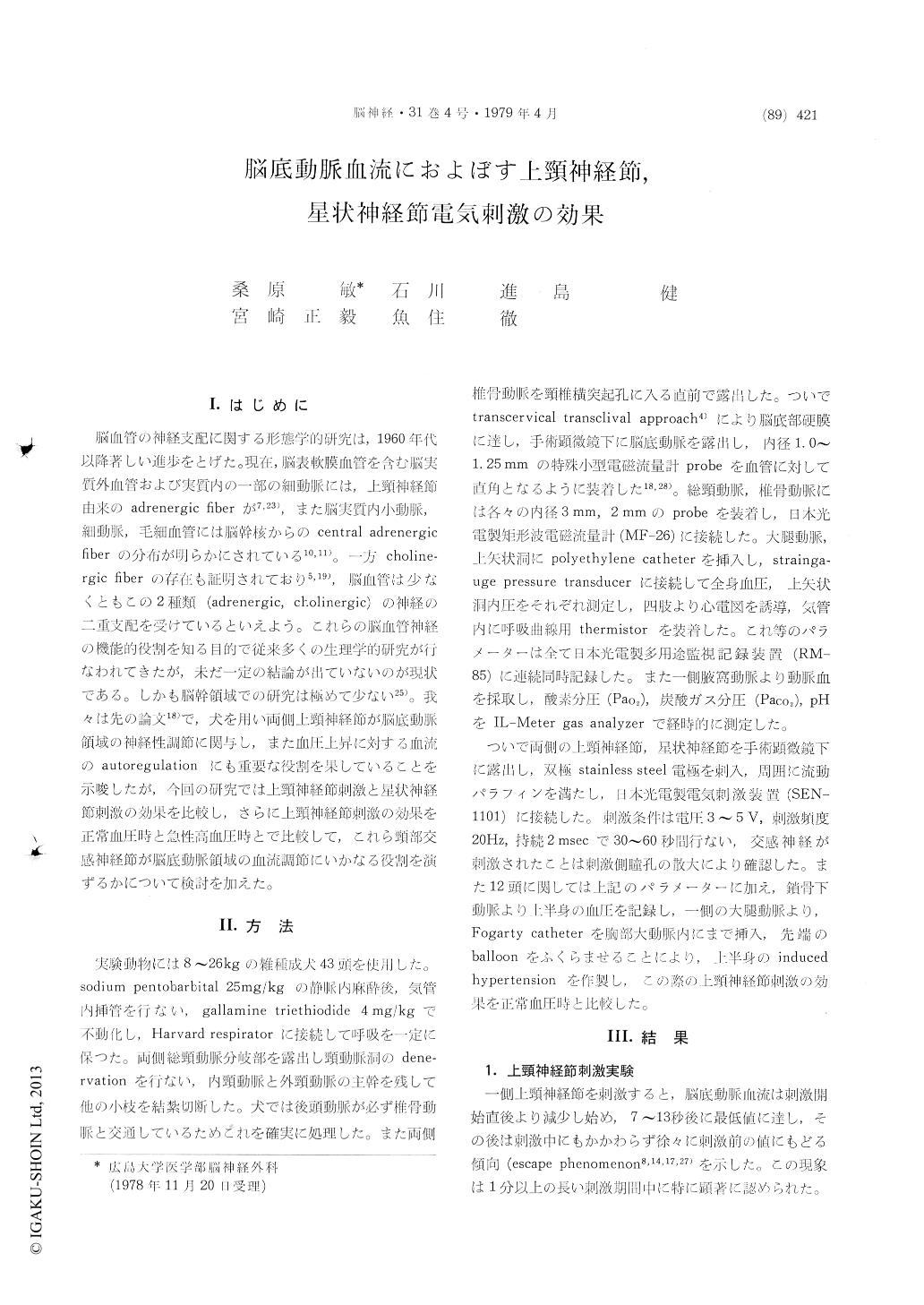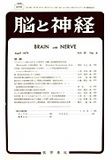Japanese
English
- 有料閲覧
- Abstract 文献概要
- 1ページ目 Look Inside
I.はじめに
脳血管の神経支配に関する形態学的研究は,1960年代以降著しい進歩をとげた。現在,脳表軟膜血管を含む脳実質外血管および実質内の一部の細動脈には,上頸神経節由来のadrenergic fiberが7,23),また脳実質内小動脈,細動脈,毛細血管には脳幹核からのcentral adrenergicfiberの分布が明らかにされている10,11)。一方choline—rgic fiberの存在も証明されており5,19),脳血管は少なくともこの2種類(adrenergic, cholinergic)の神経の二重支配を受けているといえよう。これらの脳血管神経の機能的役割を知る目的で従来多くの生理学的研究が行なわれてきたが,未だ一定の結論が出ていないのが現状である。しかも脳幹領域での研究は極めて少ない25)。我々は先の論文18)で,犬を用い両側上頸神経節が脳底動脈領域の神経性調節に関与し,また血圧上昇に対する血流のautoregulationにも重要な役割を果していることを示唆したが,今回の研究では上頸神経節刺激と星状神経節刺激の効果を比較し,さらに上頸神経節刺激の効果を正常血圧時と急性高血圧時とで比較して,これら頸部交感神経節が脳底動脈領域の血流調節にいかなる役割を演ずるかについて検討を加えた。
The present study was designed to investigate the effects of electric stimulation of the superior cervical ganglion (SCG) and stellate ganglion (STG) on basilar arterial flow in normotensive dog and the effects of SCG stimulation during acutely induced hypertension. Basilar arterial flow was measured with an electromagnetic flowmeter. Res-piration was controlled mechanically and arterial blood gases and pH were maintained within the physiological ranges.
Basilar flow started to decrease immediately after onset of electric stimulation (20 Hz) of SCG or STG and reached the lowest value within about 10 seconds. Then it increased gradually and ap-proached to the resting level despite continuance of stimulation, demonstrating the escape phenome-non. Unilateral SCG stimulation produced a de-crease in basilar flow of 11.7% (SE± 1.8) on an average and bilateral stimulation resulted in a de-crease of 26.4% (SE ±2.5), accompanying a slight rise of blood pressure. Unilateral STG stimulation caused a reduction of basilar flow of 19.0% (SE± 3.0) and bilateral stimulation was followed by a decrease of 37.3% (SE±4.8) despite a remarkablerise of blood pressure. The effect of bilateral stimulation was significantly larger than that of unilateral in both SCG and STG stimulation (p< 0.01). Reduction of basilar flow produced by bilateral stimulation of SCG was less than that caused by stimulation of STG on both sides, although the difference was not statistically sig-nificant. Changes in arterial blood gases and pH and in sagittal sinus pressure during stimulation were not statistically significant in any case.
Acute hypertension was induced by inflation of the intraaortic balloon. Unilateral SCG stimulation resulted in a decrease in basilar flow of 9.3%, which was significantly less than a reduction in normotension (p <0.05). Preexisting vasoconstric-tion in the territory of the basilar artery, which is an autoregulatory mechanism in response to a rise of blood pressure, probably reduced the effect of SCG stimulation.
The effect of electric stimulation of the cervical sympathetic ganglion is still a subject of contro-versy. The discrepancies between the results of previous studies are probably due to (1) species difference, (2) difference in site and (3) in method of measurement of cerebral blood flow (CBF), (4) difference in condition of electric stimulation. As being suggested by Seylaz et al., the effect of the escape phenomenon is especially important. When CBF is measured with a method requiring a pro-longed steady state (more than 1 to 2 minutes), a decrease in CBF will be hidden by the escape phenomenon.
Although the role of the cervical sympathetic ganglion under physiological conditions cannot be exactly estimated by the experiment of electric stimulation, the present study suggests that bilateral SCG and STG send vasoconstrictive impulses to the territory of the basilar artery and control neurogenically basilar arterial flow.

Copyright © 1979, Igaku-Shoin Ltd. All rights reserved.


